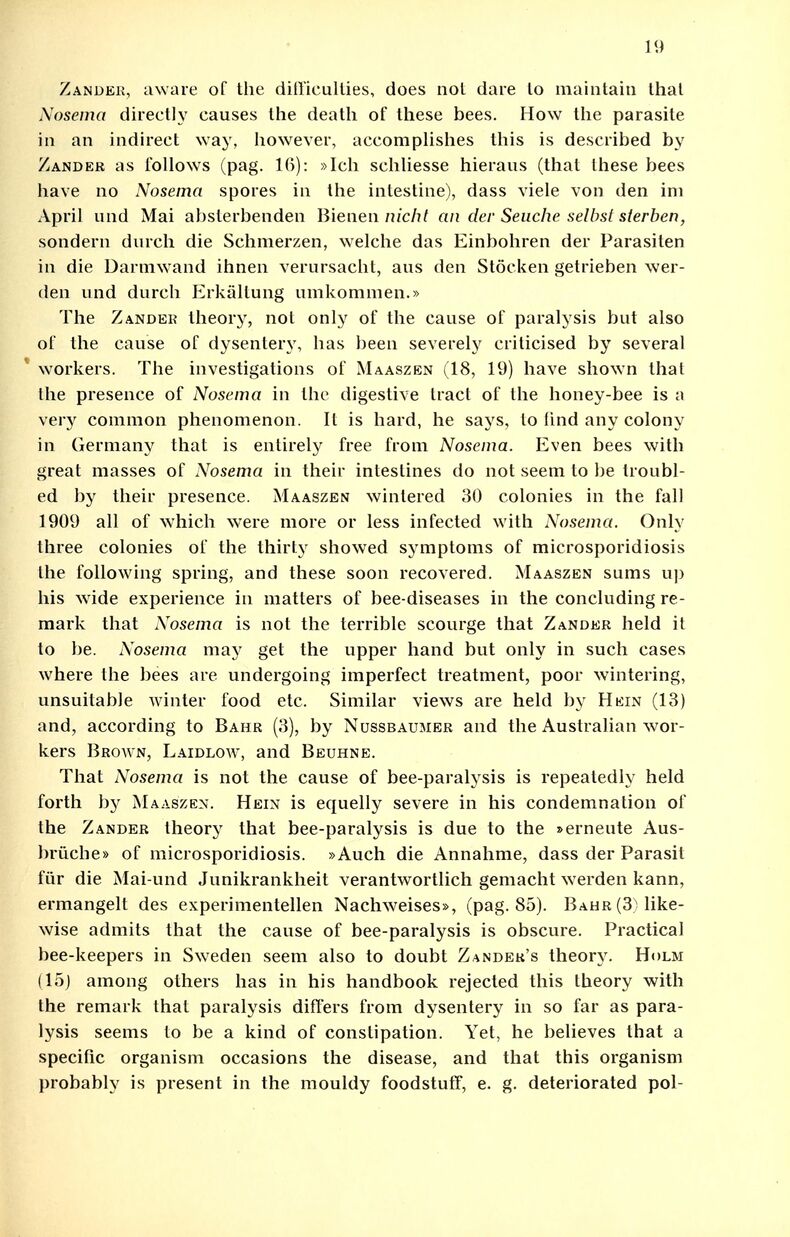
Full resolution (JPEG) - On this page / på denna sida - Sidor ...

<< prev. page << föreg. sida << >> nästa sida >> next page >>
Below is the raw OCR text
from the above scanned image.
Do you see an error? Proofread the page now!
Här nedan syns maskintolkade texten från faksimilbilden ovan.
Ser du något fel? Korrekturläs sidan nu!
This page has never been proofread. / Denna sida har aldrig korrekturlästs.
19
ZANDER, aware of the difficulties, does not dare to maintain that
Nosema directly causes the death of these bees. How the parasite
in an indirect way, however, accomplishes this is described by
ZANDER as follows (pag. 16): »Ich schliesse hieraus (that these bees
have no Nosema spores in the intestine), dass viele von den im
April und Mai absterbenden Bienen nicht an der Seuche selbst sterben,
sondern durch die Schmerzen, welche das Einbohren der Parasiten
in die Darmwand ihnen verursacht, aus den Stöcken getrieben wer-
den und durch Erkältung umkommen.»
The ZANDER theory, not only of the cause of paralysis but also
of the cause of dysentery, has been severely criticised by several
workers. The investigations of Maaszen (18, 19) have shown that
the presence of Nosema in the digestive tract of the honey-bee is a
very common phenomenon. It is hard, he says, to find any colony
in Germany that is entirely free from Nosema. Even bees with
great masses of Nosema in their intestines do not seem to be troubl-
ed by their presence. Maaszen wintered 30 colonies in the fall
1909 all of which were more or less infected with Nosema. Only
three colonies of the thirty showed symptoms of microsporidiosis
the following spring, and these soon recovered. MaaAszEN sums up
his wide experience in matters of bee-diseases in the concluding re-
mark that Nosema is not the terrible scourge that Zanper held it
to be. Nosema may get the upper hand but only in such cases
where the bees are undergoing imperfect treatment, poor wintering,
unsuitable winter food etc. Similar views are held by Hern (13)
and, according to Baur (3), by Nusspaumer and the Australian wor-
kers Brown, LarpLow, and BEUHNE.
That Nosema is not the cause of bee-paralysis is repeatedly held
forth by Maaszen. Hern is equelly severe in his condemnation of
the ZANDER theory that bee-paralysis is due to the »erneute Aus-
brüche» of microsporidiosis. »Auch die Annahme, dass der Parasit
fiir die Mai-und Junikrankheit verantwortlich gemacht werden kann,
ermangelt des experimentellen Nachweises», (pag. 85). Baur (3) like-
wise admits that the cause of bee-paralysis is obscure. Practical
bee-keepers in Sweden seem also to doubt Zanper’s theory. Horw
(15) among others has in his handbook rejected this theory with
the remark that paralysis differs from dysentery in so far as para-
lysis seems to be a kind of constipation. Yet, he believes that a
specific organism occasions the disease, and that this organism
probably is present in the mouldy foodstuff, e. g. deteriorated pol-
<< prev. page << föreg. sida << >> nästa sida >> next page >>